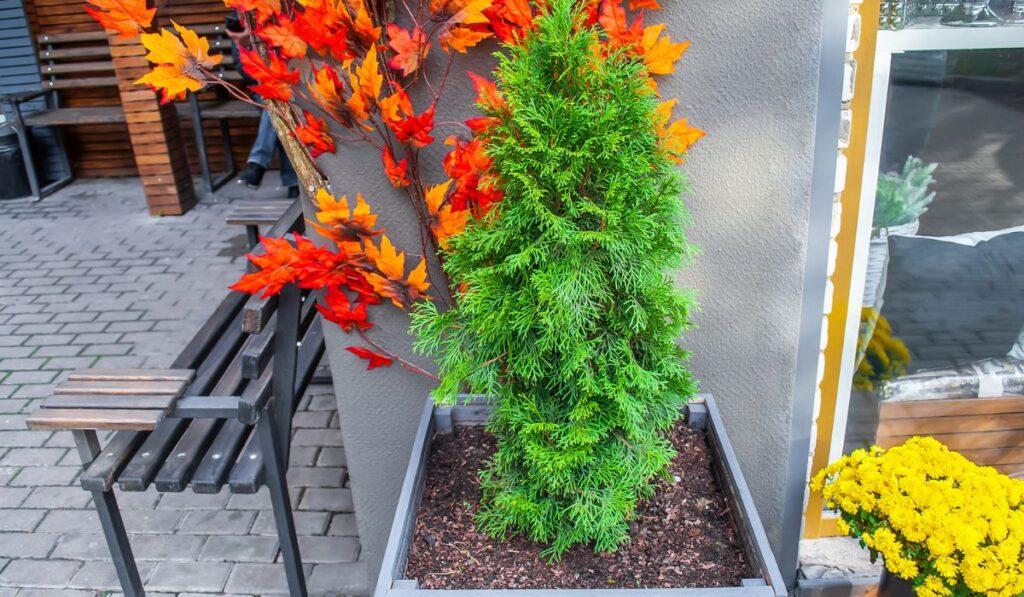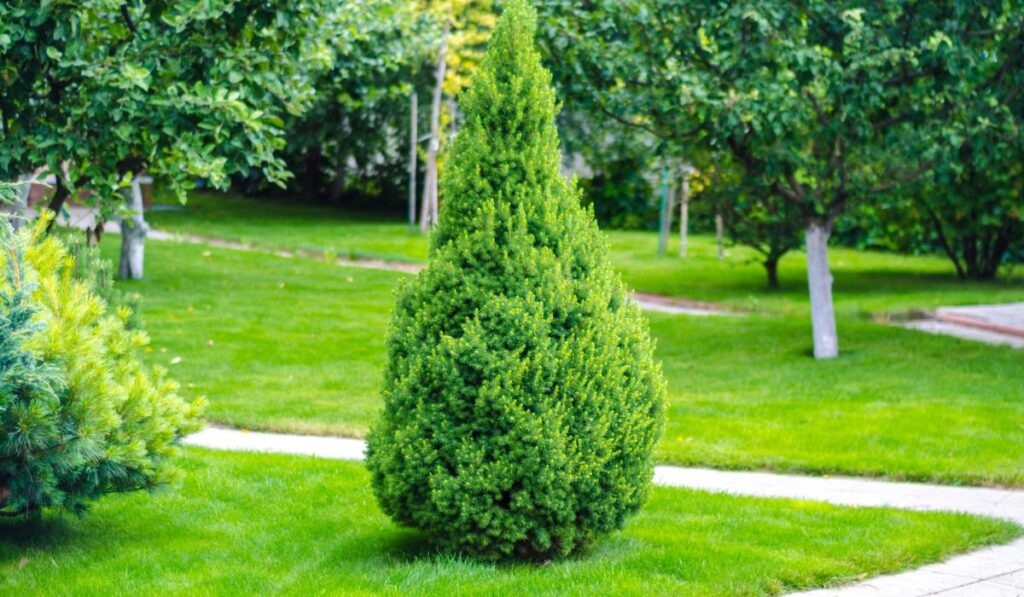Are you looking to plant the emerald green arborvitae in your garden? Nothing is challenging in planting this evergreen tree. Here is the comprehensive planting guide for the emerald green arborvitae.
A reasonably wet, well-drained soil and full sun are ideal conditions for planting emerald green arborvitae. Leave 3 to 4 feet of space between each tree when planting for privacy or as a screen, and expect the plant to reach heights between 7 and 15 feet.
As one of the densest evergreens, arborvitae requires little care. The tree is evergreen and resistant to weather and sunshine fluctuations. But that’s not everything about emerald green arborvitae. So, let’s find out about planting arborvitae in detail!
When to Plant Emerald Green Arborvitae?

This evergreen is a living column, a slender, erect cone that creates an outstanding garden hedge or screen. The dense leaves of the green arborvitae plants create a spaced hedge when planted in rows. And needs little maintenance if sited and planted correctly.
The optimum time to grow emerald green arborvitae is in the fall when it will endure minimum heat stress before the ground freezes. Or in the early spring, when the soil is workable. But depending on your location, you may be able to plant them in late winter if the soil is soft.
Where to Plant?
Consider the following areas for planting your trees:
- Create an effective winter windbreak by planting on the north side of your property.
- Plant trees on your property’s south or west side to provide shade for your residence.
- Plant wherever you require a privacy screen, living fence, or hedge.
How to Plant Emerald Green Arborvitae?
Here’s a complete guide on how to plant arborvitae so you can have a beautiful garden with these trees!
Choose the Right Place
Arborvitae prefers places that receive six or more hours of direct sunlight daily. However, several species can flourish in locations that receive 4-6 hours of sunlight daily. The greater the amount of the sun they receive, the happier they will be.
Furthermore, ensure the location where they are planted does not contain standing water during the growing season; arbs dislike having their feet wet. Eliminate all weeds, grass, and trash from the area. Then, break up the earth using a spade.
You can buy a trowel such as Fiskars Garden Hand Trowel (on Amazon), which best serves this purpose. Dig a hole around twice as wide as the root ball of your Emerald Green Arborvitae, but no deeper than its height.
Prepare Your Tree
The root ball of arborvitae sold at most garden centers is typically wrapped in burlap. Spray the root ball with a garden hose after removing the burlap.
Dig a Hole
To provide adequate room for the root system, dig a hole that is two to three times deeper and broader than the root ball.
Plant Your Emerald Green
Before inserting the arborvitae in the planting hole, carefully loosen the root ball with your hands. Backfill the hole with soil until the top of the root ball is nearly level with the top of the hole.
Once the hole is half-filled with soil, saturate the root system with water from a garden hose to eliminate air pockets. Continue backfilling until all void space surrounding the root ball has been filled. Gently compact the soil, then thoroughly water it.
Maintaining Emerald Green Arborvitae
Maintenance of the emerald green arborvitae isn’t hard. But there are some factors to consider. Read further to learn about them!
Sunlight
Although emerald, green arborvitae like full sunlight, they can also thrive in shady areas. Plant these shrubs where they receive at least six hours of direct sunlight daily.
Soil
Arborvitae should be planted in neutral to alkaline-pH soil that is moist but well-drained. Each year, add a thick layer of manure or mulch over the root zone to maintain soil moisture. These shrubs do not like to have their roots in soggy soil.
Water
Your arborvitae will require twice-weekly watering for the first few months following planting, followed by weekly watering (about 1 inch) for the next year or two. Once planted, ensure that the plant receives approximately 0.5 inches of water per week by rainfall or irrigation.
Pruning
Before the emergence of new growth in early spring, cut an Emerald Green Arborvitae, washing the blades of your pruning shears with rubbing alcohol to avoid spreading diseases and insects.
When growing Emerald Green Arborvitae as a hedge, you can also prune the trees in late summer to preserve a uniform shape. You can buy a fantastic pruning tool like Fiskars Bypass Pruning Shears (on Amazon) to handle regular pruning.
Fertilizer
Emerald Green thrives without fertilizer in all but the most deficient soils. However, broadcast 16-16-16 granular fertilizer at the plant’s base in the spring for an optional boost. For young trees, two tablespoons per plant are recommended.
For trees taller than six feet, increase the amount to a quarter cup. Spread the granules around 12 inches out from the trunk and lightly scratch them into the soil. Then, thoroughly saturate the area with water so the fertilizer may contact the soil and begin functioning.
Other Types of Arborvitae Trees

These evergreens are tall, thick, and broad-pyramidal. These trees can reach heights between 40 and 60 feet. Select plants with sturdy core stems to prevent wind, snow, and ice damage. Here are some additional Arborvitae species that can be grown in your garden.
American Arborvitae
The eastern or American arborvitae is a popular garden plant. Eastern arborvitaes flourish in well-drained soil and full sun in home gardens. American arborvitaes can grow to a height of 49 ft.
Giant Arborvitae
The enormous arborvitae, sometimes known as western red cedar, is a massive coniferous tree. Certain dwarf western arborvitae species are ideal for use in front or rear yards. The enormous arborvitae has a conical form and luxuriant evergreen foliage.
Globe Arborvitae
The remarkable aspect of these trees is that the Globe Arborvitae attains its spherical shape without external assistance or pruning. Its peak height is typically less than 5 feet, making it particularly effective as a wind block or for protecting tiny plants.
Tom Thumb
It is a dwarf that barely reaches 12 to 15 inches tall. It is a thick, multi-stemmed, rounded shrub that is ideal for pots or rock gardens.
Pests and Diseases
The good news is that arborvitaes do not have many insect enemies. The same holds true about diseases. However, they may succumb to needle and twig blight due to a fungal infection, particularly if air circulation is impeded by overcrowding the plants. To eliminate blight, remove all infected branches and apply a fungicide.
Additionally, bagworms enjoy feeding on the foliage of arborvitaes and other evergreens. Additionally, spider mites and stem canker can be issues. These are some significant pests that may damage your emerald green plant.
- Spider mites.
- Pestiferous bugs.
- Bagworms.
- Branch cracker.
Here are some of the most prevalent illnesses recorded for these trees:
- Twig Blight.
- Canker disease.
- Cercospora Blight.
- Black Mold.
Conclusion
Emerald green arborvitae is one of the most planted evergreen plants (read our guide on how to plant evergreen trees). They are mainly planted as a fence or shield around the house. Planting these trees doesn’t require gardening expertise as they require significantly less maintenance and care.
With the help of this guide, you can easily plan your Emerald green arborvitae in your garden. Take good care of your plants; you will see them grow ideally into a fence.
